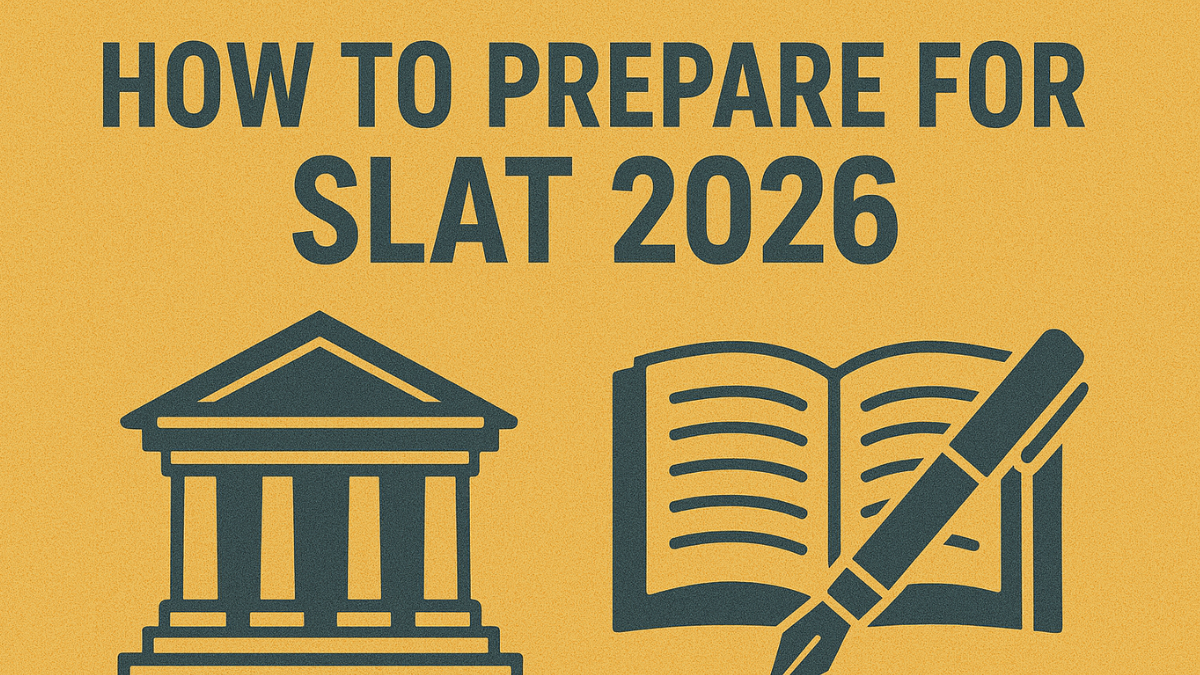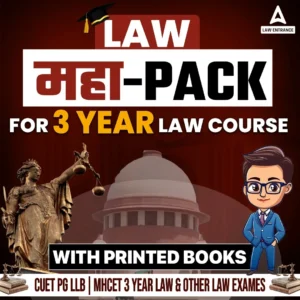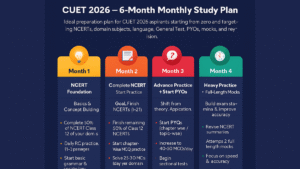Symbiosis International (Deemed University) is scheduled to conduct the Symbiosis Law Admission Test (SLAT) 2026 on two dates, i.e Test 1 is on December 20 and Test 2 on December 24, 2025. With only a few days until the law entrance exam, the students must boost their preparation effectively and strategically. In this blog, we emphasise a planned, strategic, and methodical approach to how to prepare for SLAT 2026 in the last 30 days, covering key aspects like understanding the exam format and key topics, developing a study plan and so on.
How to Prepare for SLAT 2026?
The strategy for the SLAT preparation in the last 30 days should be more exam-oriented and mostly focus on revising. To prepare for the SLAT Exam in one month, follow a structured revision plan that includes reading key topics where questions are frequently asked, developing a habit of reading daily newspapers for GK, regular practice with mock tests and previous year papers, and memorising frequently asked vocabulary and basic concepts.
Aside from these practices, you must discipline yourself by adhering to a strict timetable, avoiding social media, devoting time to analysing your blunders in mock tests to find weak areas, and prioritising areas where you can score the most marks.
SLAT Exam Pattern
Understanding the SLAT paper pattern is one of the initial stages to getting ready for the examination. As per the official notification, the SLAT question paper includes a total of 60 questions and each carrying 1 mark. The duration of the exam is 60 minutes. Check out the section-wise question mark distribution below
| Section | No. of Questions | Marks |
| Logical Reasoning | 12 | 12 |
| Legal Reasoning | 12 | 12 |
| Analytical Reasoning | 12 | 12 |
| Reading Comprehension | 12 | 12 |
| General Knowledge | 12 | 12 |
| Total | 60 | 60 |
SLAT Section-wise Key Topics
The official syllabus of SLAT 2026 only indicates the SLAT exam pattern. whereas the detailed section-wise topics are not mentioned. Below, we have shared the section-wise key topics of the SLAT Exam syllabus based on an analysis of prior exam papers.
| Sections | SLAT Important Topics |
| Logical Reasoning |
|
| Legal Reasoning |
|
| Analytical Reasoning |
|
| Reading Comprehension | Vocabulary, grammar fundamentals (tenses, conjunctions, prepositions), sentence improvement, reading skills |
| General Knowledge |
|
Phases of SLAT Preparation 2026 in Last 30 days
We have divided the Last 20 days of the SLAT Exam into four phases. Each phase of the preparation has a unique agenda. Students may refer to this study plan to make their own.

30-Day Study Calendar for SLAT 2026
After a thorough analysis of the exam pattern, syllabus, highweigtages topics below, we have shared a 30-day study plan for SLAt2026 preparation. It should be noted that this SLAT Study Plan is only for reference purposes, so that you can plan your practice session and revision session.
|
SLAT 2026 – 30-Day Study Calendar
|
|
| Day 1 | • Legal Reasoning: Concepts + 20–40 Q • Logical Reasoning: 20–30 Q • Analytical Reasoning: 15–25 Q • RC: 2–3 Passages • GK: 30–50 Facts/CA |
| Day 2 | • Legal Reasoning: Concepts + 20–40 Q • Logical Reasoning: 20–30 Q • Analytical Reasoning: 15–25 Q • RC: 2–3 Passages • GK: 30–50 Facts/CA |
| Day 3 | • Legal Reasoning: Concepts + 20–40 Q • Logical Reasoning: 20–30 Q • Analytical Reasoning: 15–25 Q • RC: 2–3 Passages • GK: 30–50 Facts/CA |
| Day 4 | • Legal Reasoning: Concepts + 20–40 Q • Logical Reasoning: 20–30 Q • Analytical Reasoning: 15–25 Q • RC: 2–3 Passages • GK: 30–50 Facts/CA |
| Day 5 | • Legal Reasoning: Concepts + 20–40 Q • Logical Reasoning: 20–30 Q • Analytical Reasoning: 15–25 Q • RC: 2–3 Passages • GK: 30–50 Facts/CA |
| Day 6 | • Legal Reasoning: Concepts + 20–40 Q • Logical Reasoning: 20–30 Q • Analytical Reasoning: 15–25 Q • RC: 2–3 Passages • GK: 30–50 Facts/CA |
| Day 7 | • Legal Reasoning: Concepts + 20–40 Q • Logical Reasoning: 20–30 Q • Analytical Reasoning: 15–25 Q • RC: 2–3 Passages • GK: 30–50 Facts/CA |
| Day 8 | • Legal Reasoning: Concepts + 20–40 Q • Logical Reasoning: 20–30 Q • Analytical Reasoning: 15–25 Q • RC: 2–3 Passages • GK: 30–50 Facts/CA |
| Day 9 |
• Legal Reasoning: Concepts + 20–40 Q
• Logical Reasoning: 20–30 Q • Analytical Reasoning: 15–25 Q • RC: 2–3 Passages • GK: 30–50 Facts/CA |
| Day 10 |
• Legal Reasoning: Concepts + 20–40 Q
• Logical Reasoning: 20–30 Q • Analytical Reasoning: 15–25 Q • RC: 2–3 Passages • GK: 30–50 Facts/CA |
| Day 11 |
• Legal Reasoning: Concepts + 20–40 Q
• Logical Reasoning: 20–30 Q • Analytical Reasoning: 15–25 Q • RC: 2–3 Passages • GK: 30–50 Facts/CA |
| Day 12 |
• Legal Reasoning: Concepts + 20–40 Q
• Logical Reasoning: 20–30 Q • Analytical Reasoning: 15–25 Q • RC: 2–3 Passages • GK: 30–50 Facts/CA |
| Day 13 |
• Legal Reasoning: Concepts + 20–40 Q
• Logical Reasoning: 20–30 Q • Analytical Reasoning: 15–25 Q • RC: 2–3 Passages • GK: 30–50 Facts/CA |
| Day 14 |
• Legal Reasoning: Concepts + 20–40 Q
• Logical Reasoning: 20–30 Q • Analytical Reasoning: 15–25 Q • RC: 2–3 Passages • GK: 30–50 Facts/CA |
| Day 15 | • Legal Reasoning: Concepts + 20–40 Q • Logical Reasoning: 20–30 Q • Analytical Reasoning: 15–25 Q • RC: 2–3 Passages • GK: 30–50 Facts/CA |
| Day 16 | • Legal Reasoning: Concepts + 20–40 Q • Logical Reasoning: 20–30 Q • Analytical Reasoning: 15–25 Q • RC: 2–3 Passages • GK: 30–50 Facts/CA |
| Day 17 | • Legal Reasoning: Concepts + 20–40 Q • Logical Reasoning: 20–30 Q • Analytical Reasoning: 15–25 Q • RC: 2–3 Passages • GK: 30–50 Facts/CA |
| Day 18 | • Legal Reasoning: Concepts + 20–40 Q • Logical Reasoning: 20–30 Q • Analytical Reasoning: 15–25 Q • RC: 2–3 Passages • GK: 30–50 Facts/CA |
| Day 19 | • Legal Reasoning: Concepts + 20–40 Q • Logical Reasoning: 20–30 Q • Analytical Reasoning: 15–25 Q • RC: 2–3 Passages • GK: 30–50 Facts/CA |
| Day 20 | • Legal Reasoning: Concepts + 20–40 Q • Logical Reasoning: 20–30 Q • Analytical Reasoning: 15–25 Q • RC: 2–3 Passages • GK: 30–50 Facts/CA |
| Day 21 |
• Legal Reasoning: Concepts + 20–40 Q
• Logical Reasoning: 20–30 Q • Analytical Reasoning: 15–25 Q • RC: 2–3 Passages • GK: 30–50 Facts/CA |
| Day 22 |
• Legal Reasoning: Concepts + 20–40 Q
• Logical Reasoning: 20–30 Q • Analytical Reasoning: 15–25 Q • RC: 2–3 Passages • GK: 30–50 Facts/CA |
| Day 23 | • Legal Reasoning: Concepts + 20–40 Q • Logical Reasoning: 20–30 Q • Analytical Reasoning: 15–25 Q • RC: 2–3 Passages • GK: 30–50 Facts/CA |
| Day 24 | • Legal Reasoning: Concepts + 20–40 Q • Logical Reasoning: 20–30 Q • Analytical Reasoning: 15–25 Q • RC: 2–3 Passages • GK: 30–50 Facts/CA |
| Day 25 |
• Legal Reasoning: Concepts + 20–40 Q
• Logical Reasoning: 20–30 Q • Analytical Reasoning: 15–25 Q • RC: 2–3 Passages • GK: 30–50 Facts/CA |
| Day 26 | • Legal Reasoning: Concepts + 20–40 Q • Logical Reasoning: 20–30 Q • Analytical Reasoning: 15–25 Q • RC: 2–3 Passages • GK: 30–50 Facts/CA |
| Day 27 | • Legal Reasoning: Concepts + 20–40 Q • Logical Reasoning: 20–30 Q • Analytical Reasoning: 15–25 Q • RC: 2–3 Passages • GK: 30–50 Facts/CA |
| Day 28 | • Legal Reasoning: Concepts + 20–40 Q • Logical Reasoning: 20–30 Q • Analytical Reasoning: 15–25 Q • RC: 2–3 Passages • GK: 30–50 Facts/CA |
| Day 29 |
• Legal Reasoning: Concepts + 20–40 Q
• Logical Reasoning: 20–30 Q • Analytical Reasoning: 15–25 Q • RC: 2–3 Passages • GK: 30–50 Facts/CA |
| Day 30 | • Legal Reasoning: Concepts + 20–40 Q • Logical Reasoning: 20–30 Q • Analytical Reasoning: 15–25 Q • RC: 2–3 Passages • GK: 30–50 Facts/CA |
SLAT Section-Wise Preparation 2026
The SLAT (Symbiosis Law Admission Test) is an important admission exam for students who want to attend undergraduate law programs at Symbiosis Law Schools. The key to success is to understand what is included in the SLAT 2026 syllabus and approach it carefully. This exam, which covers logical reasoning, legal reasoning, analytical ability, reading comprehension, and general knowledge, requires a well-structured approach. Below, we’ve shared the complete SLAT section-wise preparation strategy to get unlimited success.
1. Logical Reasoning
To prepare for the maths portion in the last 30 days, you must focus on practising more questions with varying difficulty levels to increase your ability to detect patterns, correlations, and logical connections. It will help you build problem-solving methods that you may use in the exam hall. Math covers topics such as percentages, averages, ratios, time-speed, and data interpretation.
2. Legal Reasoning
Legal reasoning questions on the Symbiosis entrance test frequently include applying a certain legal principle to a group of facts. You don’t need to do phd in the section, but familiarising yourself with fundamental legal principles might be advantageous. Practice answering mock tests and PYQs to strengthen your legal thinking skills.
3. Analytical Ability
Analytical Ability is frequently considered the most difficult segment of the exam because it includes questions on mathematical concepts and data interpretation. In the remaining few days, you should spend more time on basic mathematical ideas from subjects such as arithmetic, algebra, geometry, and statistics. Also, one should regularly practice with questions to improve your speed and accuracy.
4. Reading Comprehension
The Reading Comprehension section examines your ability to comprehend and interpret written passages. To increase your reading speed and comprehension, you should now set aside one hour per day to read newspapers, magazines, and novels. It is highly advisable for students that reading a variety of genres will help them better grasp different writing styles.
5. General Knowledge
This section of the SLAT question paper is quite unexpected. Questions are mainly based on current events from the last 12 months, static GK, awards, sports, politics, and so forth. In the last 30 days, you should maintain the habit of reading diverse newspapers. You can find trustworthy and national-level newspapers that report accurate news and editorial content.
| SLAT 2026 | |
| SLAT Cut-Off | SLAT Eligibility |
| SLAT Exam Date | |
| SLAT Question Paper | SLAT Result |
| SLAT Syllabus | |


 MHT CET Notification 2026 (OUT) – Know...
MHT CET Notification 2026 (OUT) – Know...
 CUET Preparation Strategy for Students T...
CUET Preparation Strategy for Students T...
 CUET Study Plan 2026, Preparation Strate...
CUET Study Plan 2026, Preparation Strate...
